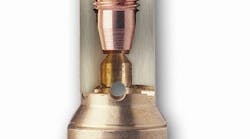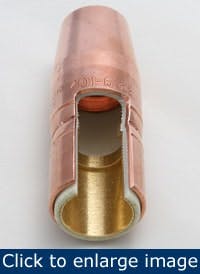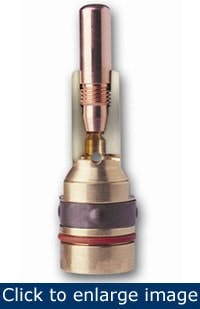Simple tips to increase MIG gun consumable effectiveness
Even though many consider MIG gun consumables to be a commodity — a simple ‘throw-away’ item — these components play a critical role in achieving good welding performance and quality. They can also affect the overall productivity and cost of your welding operation, often in some rather subtle ways. For both reasons, it’s crucial to find the best possible, longest lasting consumables for your application and maintain them with as much care as you would any other welding equipment.
[pullquote]MIG gun consumables, which comprise the front-end part of the gun — the nozzle, retaining head and contact tip — plus the liner, are at the heart of the welding process. These components are responsible for feeding the welding wire and for establishing the electrical conductivity necessary to produce the arc. And while the welding power source you use undoubtedly influences your operation’s performance, so too can your consumables. In fact, MIG gun consumables are one of the most overlooked portions of the welding operation. Without proper installation, storage and maintenance, these components can cause significant downtime for changeover and added cost for inventory, waste and rework.
Fortunately, through a few simple measures, you can extend the life of these components and positively affect the efficiency and profit of your welding operation. Here’s how.
Start at the beginning
Figure 1. Select a nozzle with a smooth surface to prevent spatter accumulation that can lead to downtime and shorten the life of the component. Note, this cut-away shows the inside nozzle insulator.
In the MIG welding process, the nozzle directs the shielding gas around the welding wire and arc to the weld puddle (Figure 1). Its purpose is to protect the weld from the atmosphere and other contaminants that can cause weld defects, such as porosity, that can lead to costly rework. Unfortunately, because of its proximity to the weld puddle, the nozzle is a common source of spatter accumulation that can obstruct the proper flow of shielding gas.
To prevent such problems, first consider the nozzle itself. Look for a smooth, non-porous surface free of sharp edges or flat spots, as it better resists spatter accumulation and, therefore, lasts longer. Also, choose nozzles that have some heft to them — they should look and feel sturdy. Heavier nozzles might cost more up front, but their longevity can help prevent downtime that will likely cost you more money over time.
Proper nozzle storage and handling is critical to extending the life of this component. First, keep the nozzle in its original packaging until you’re ready to use it. Unwrapping the nozzle to store it in a bin, while a common practice, dents and scratches the nozzle surface, making it more prone to spatter accumulation. Nozzles unprotected from the environment also can accumulate air-borne contaminants or debris, which, if introduced into the weld puddle, might cause defects that need to be reworked.
Generally, semi-automatic MIG gun applications use slip-on nozzles. When installing one, make certain to connect the nozzle to the retaining head securely to prevent shielding gas leaks that can lead to weld defects. Also, be mindful whether you have any debris, grease or oil on your hands or gloves. Keep the nozzle as clean as possible to prevent contamination from entering the weld puddle later or causing premature component failure.
Consider using an anti-spatter compound (gels are commonly used in semi-automatic applications) to reduce the amount of spatter that adheres to the nozzle. Apply the compound by dipping only the front 1.5 in. of the nozzle into the compound. Don’t submerge the nozzle, as this can saturate the internal porous insulator, causing it to fail prematurely, accumulate spatter more readily and produce an erratic arc — all factors that lead to downtime, extra costs and waste associated with changing over to a new nozzle.
Next, periodically inspect the inside and outside of the nozzle visually for spatter, ideally several times throughout the welding shift. If it appears clogged, clean the nozzle using a tool specifically designed for the job or replace it if necessary.
Finally, never use the nozzle to chip away at spatter or for any other hammering purpose. Doing so damages not only the MIG gun, but it can dent or misshapen the nozzle, rendering it unusable.
Keep connected
Good welding performance depends on good electrical conductivity. Look for a contact tip system — the contact tip and retaining head — that stays tight or has locking features (Figure 2). The retaining head (also called a diffuser) is the component that forms the connection between the nozzle and the MIG gun neck, and holds the contact tip in place. This component also provides the surface area necessary to carry the electrical current to the contact tip to produce an arc. If the connection between the retaining head and contact tip isn’t secure, it can introduce electrical resistance that leads to overheating, causing the components to fail.
Use the correct diameter contact tip for your welding wire. This ensures your arc remains stable and that the contact tip doesn’t become too hot. Also, look for a design that allows the contact tip to be rotated to expose a new wear surface when keyholing occurs. Keyholing is the result of the constant pressure of the welding wire feeding through the bore in the contact tip and eroding it. To further reduce downtime, waste and cost, use a contact tip that has a rounded end, as opposed to flat, because this shape tends to ward off spatter better.
Figure 2. Achieve good electrical conductivity by selecting a contact tip system (as shown in this cut-away) that stays tight or has locking features.
Similar to nozzles, store and handle contact tips and retaining heads properly. Keep them in their packages until you’re ready to use them and take care that they remain free of contaminants. For instance, any oil or debris present on a contact tip can become trapped when you thread the tip into the retaining head, which, in turn, can cause the components to overheat and fail during welding.
Tighten the retaining head to the manufacturer’s specifications by hand or by using a recommended tool. This ensures a secure connection between the retaining head and the MIG gun neck and prevents shielding gas leaks and minimizes electrical resistance. Similarly, when installing the contact tip, tighten the components securely using a pair of welding pliers (sometimes called welpers). Don’t use wire cutters, as these scratch the contact tip or deform it entirely — any such damage shortens the tip’s life and might lead to costly downtime and rework.
As with nozzles, inspect the contact tip regularly for spatter build-up and replace it as needed. Frequent inspections save time and money in the long run, if you consider the potential downtime for rework resulting from a damaged contact tip. The frequency of changeover depends on your specific application. Most importantly, check that your contact tip and retaining head haven’t loosened while welding. Tighten the components accordingly to ensure you have a solid electrical connection. Remember, good conductivity results in better weld quality. Plus, it helps these components last longer.
Line up
Figure 3. Trim the liner to the correct length to prevent wire-feeding problems and to prevent the contact tip from failing prematurely.
A MIG gun liner (Figure 3) spans the length from the front of the MIG gun to the power pin and is the conduit through which the welding wire feeds. It’s generally composed of a steel coil, but if you’re welding with aluminum wire, you’ll need to choose a nylon liner or one of similar material. As when choosing a contact tip, select the correct diameter liner for your welding wire to prevent wire-feeding, arc wandering or other problems such as bird nesting. This phenomenon occurs when the welding wire becomes tangled in the drive rolls. It’s also caused by an improperly installed liner or by using the wrong drive roll tension.
Properly trimming your MIG gun liner significantly increases the longevity of this component. Always follow the manufacturer’s recommendations, using the proper cutting tools and trimming the liner to the correct length. Cutting the liner too short results in improper alignment with the retaining head and causes the welding wire to feed off-center through the contact tip. This not only wears out the contact tip prematurely, but it allows debris to build up between the liner and retaining head, resulting in wire feeding problems. A liner that is too long can kink, which also leads to feeding problems and shortens contact tip life. After trimming the liner, ensure there are no burrs or sharp edges. You also might want to consider using a liner that loads from the front of the MIG gun. This style of liner can save time for installation and might help avoid some of the pitfalls common to installing a standard, full-length liner.
When installing your MIG gun liner, keep it (as much as possible) away from contaminants, as debris causes blockages that lead to feeding problems and welding wire damage. Don’t let the liner drag on the floor, but instead wrap it in a coil in one hand as you feed it through the MIG gun, and make certain that your hands or gloves are clean. The frequency by which you need to change your MIG gun liner depends largely on the welding application, the type of welding wire used and the duration and amperage of welding. Track the span of time from one installation to the next and use that timeframe as a guideline for how long a liner will likely last. Some welding operators also blow compressed air through the liner periodically to extend the component’s life.
Other means to increase the life of a MIG gun liner include using the shortest MIG gun cable length possible for the welding application and keeping the cable clear of equipment, such as a forklift, that could damage it. Both measures help prevent kinking and minimize the chance of poor wire feeding that could lead to downtime.
While MIG gun components are just one part of your welding operation, being mindful of the effect they have on quality and cost is important. Nozzles, contact tips, retaining heads and liners each perform a function vital to the whole of the welding process and should be purchased, installed and maintained with care. Doing so not only prevents the cost of downtime for changeover, maintaining excessive inventory and rework, but it can affect your bottom line — positively — through better weld quality and greater productivity.
David Bellamy is product manager and Jeff Wells is engineering manager at the Semi-Automatic and Consumables Group, Tregaskiss, Windsor, Ontario. Contact them at (519) 737-3000.



